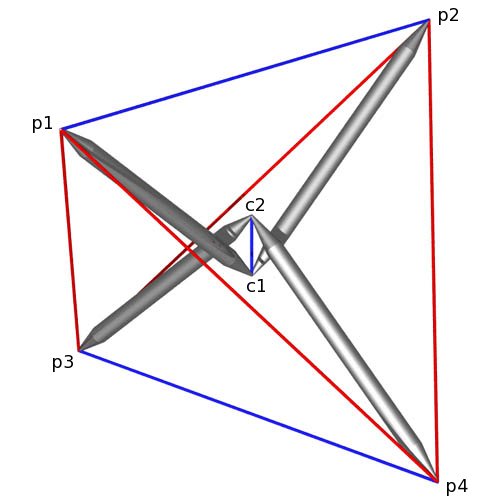
Tensegrity Tetrahedron Point Labels
structure file: tetra/tetra3.rc variable file: tetra/tetra3.dat |
Member Descriptions
[name, end point names, weight (if in objective function),
second power of length (if a constraint), member category,
Obj/Con/Exc (put in objective function, use as a constraint or
exclude from computations), flags]
For assembly purposes, only the name and end point names are
of interest. The other information may be of interest after
A Practical Guide to Tensegrity Design has been consulted.
# struts
<Member> s1 c1 p1 -1.00 sqr(330) 1 Con *
<Member> s2 c1 p2 -1.00 sqr(330) 1 Con *
<Member> s3 c2 p3 -1.00 sqr(330) 1 Con *
<Member> s4 c2 p4 -1.00 sqr(330) 1 Con *
# tendons
<Member> t1-2 p1 p2 1.00 sqr(498.5297) 3 Con *
<Member> t1-3 p1 p3 1.00 sqr(498.5297) 2 Con *
<Member> t1-4 p1 p4 1.00 sqr(498.5297) 2 Con *
<Member> t2-3 p2 p3 1.00 sqr(498.5297) 2 Con *
<Member> t2-4 p2 p4 1.00 sqr(498.5297) 2 Con *
<Member> t3-4 p3 p4 1.00 sqr(498.5297) 3 Con *
<Member> tc c1 c2 1.00 sqr(80) 3 Obj *
In-Situ Member Lengths
These are the lengths of the members when they are in place
and prestress is applied. The strut lengths are from
screw-eye center to screw-eye center, as are the tendon lengths.
The values are in model units.
s1: 330 s2: 330 s3: 330
s4: 330 t1-2: 498.53 t1-3: 498.53
t1-4: 498.53 t2-3: 498.53 t2-4: 498.53
t3-4: 498.53 tc: 80
Relative Member Force Magnitudes
These values are useful for developing an assembly
strategy for the structure. The tighter tendons are much
easier to tie in place early on, while the looser tendons
can be left to the last. This information is also used
to adjust tendon lengths since the measured length of a tendon
will be shorter for a highly-stressed tendon with the same
in-situ length as a tendon which is not so stressed.
s1: -61.0385 s2: -61.0385 s3: -61.0385
s4: -61.0385 t1-2: 17.8211 t1-3: 28.2843
t1-4: 28.2843 t2-3: 28.2843 t2-4: 28.2843
t3-4: 17.8211 tc: 80
Average tendon force magnitude: 32.6827
Construction Lengths (in mm and halves)
The construction length of a tendon is less than the in-situ
length since when the tendon is measured off it isn't under
any prestress force. The construction length for a member
represents the distance between the locations where it
departs from the hub. The struts were cut from
3/4-inch diameter hardwood dowel. The tendons were made
of single strands of twisted #18 nylon twine. Its behavior
under stress is highly non-linear, so a look-up table
was used to compute strains. Prestress forces were assumed
to affect tendon lengths and not strut lengths. For the tc
member, a double hook was used that kept the screw-eye centers
80 mm apart.
stress-strain chart: v04oct_d/wellingtn.ssc
Average Tendon Force Magnitude (chart units)> 15
Length Scale Factor> 1
Strut and Tendon Hub Adjustments - s;t> 13 8
(subtract 2*(13 mm) off strut lengths to get dowel lengths;
subtract 2*(8 mm) off tendon lengths to get hub-adjusted
in-situ tendon lengths)
s1: 304 0 s2: 304 0 s3: 304 0 s4: 304 0
t1-2: 460 1 t1-3: 451 0 t1-4: 451 0 t2-3: 451 0
t2-4: 451 0 t3-4: 460 1 tc: 80 0

Tensegrity Tetrahedron Point Labels
structure file: tetra/tetra3.rc variable file: tetra/tetra3.dat |
CONTACT:
Bob Burkhardt
Tensegrity Solutions
Box 426164
Cambridge, MA 02142-0021
USA
e-mail: bobwb@juno.com